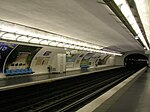Lycée Hélène Boucher (Tremblay-en-France)
French school stubsLycées in Seine-Saint-Denis
Lycée des métiers Hélène Boucher is a vocational senior high school in Tremblay-en-France, Seine-Saint-Denis, France, in the Paris metropolitan area. In August 2016 a riot broke out outside of the high school.
Excerpt from the Wikipedia article Lycée Hélène Boucher (Tremblay-en-France) (License: CC BY-SA 3.0, Authors).Lycée Hélène Boucher (Tremblay-en-France)
Cours de Vincennes, Paris Quartier de Charonne (Paris)
Geographical coordinates (GPS) Address Nearby Places Show on map
Geographical coordinates (GPS)
| Latitude | Longitude |
|---|---|
| N 48.848 ° | E 2.407 ° |
Address
Collège et Lycée Hélène Boucher
Cours de Vincennes
75020 Paris, Quartier de Charonne (Paris)
Ile-de-France, France
Open on Google Maps









